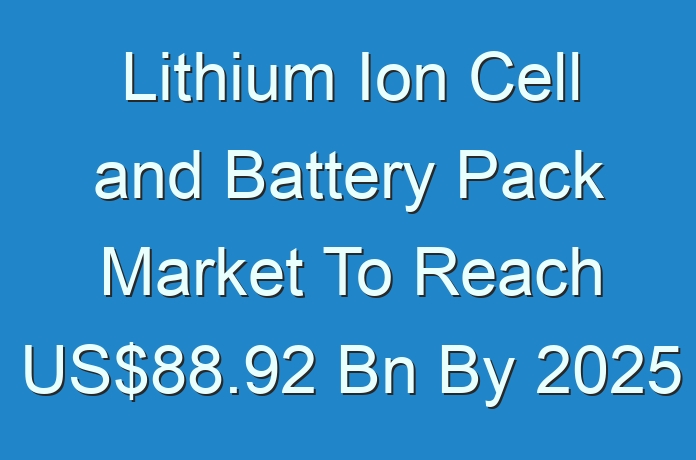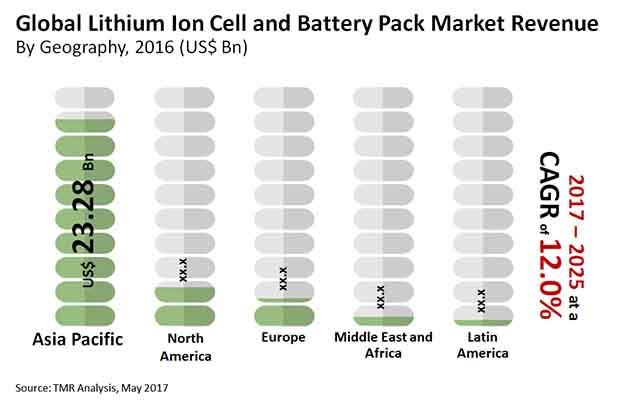
Global Lithium Ion Cell and Battery Pack Market: Snapshot
The lithium ion cell and battery pack market is gaining momentum as lithium-ion batteries offer advantages of higher efficiency and longer lifespan over other batteries such as lead acid ones. The rising demand for electronics with improved battery life and superior performance is expected to stir demand for lithium-ion batteries among manufacturers of consumer electronics. This is because lithium-ion batteries satisfy the demand for high power density needed by handheld devices for wireless data transmission and brighter resolution.
The increasing use of lithium ion batteries in barcode and RFID scanners due to their high energy density is also influencing the growth of lithium ion cell and battery packs market. Furthermore, the use of these batteries is rapidly gaining momentum in automotive, industrial, and energy sectors with the rising shift for sustainable clean fuels.
However, factors such as high prices of lithium-ion batteries that make them unsustainable for prolonged use such as in electric vehicles and their lower thermal stability are restraining the market’s growth.
Request Brochure @
https://www.transparencymarketresearch.com/sample/sample.php?flag=B&rep_id=26408
The global lithium ion cell and battery pack market is expected to grow at a CAGR of 12.0% between 2017 and 2025. The market stood at a valuation of US$32.17 bn in 2016 and is expected to reach a valuation of US$88.92 bn by 2025.

Consumer Electronics Application Segment to Continue to Lead in Coming Years
In terms of power capacity, the lithium ion cell and battery pack market has been segmented into 5-25 Wh, 48-95 Wh, 18-28 KWh, 100-250 KWh, more than 300 KWh. Among these, 100-250 KWh stood as the most attractive segment in 2016 based on power capacity. The growth of this segment is primarily driven by demand for high capacity batteries for specific applications such as in high loading electric vehicles. The 18-28 KWh and more than 300 KWh segments are also expected to display considerable growth due to their applications in grid energy production.
REQUEST FOR COVID19 IMPACT ANALYSIS –
https://www.transparencymarketresearch.com/sample/sample.php?flag=covid19&rep_id=26408
In terms of pack type, series battery pack, parallel battery pack, and others are the segments into which the lithium ion cell and battery pack market is divided. The other battery pack stood as the leading segment in 2016 commanding a share of 83.9% in the overall market. The other battery pack segment is expected to lead throughout the forecast period attributed to their extensive applications across industry verticals. On the other hand, series and parallel battery packs have lower market shares due to their specific applications.
On the basis of shape, cylindrical, polygon, prismatic, and coin among others are segments into which the lithium ion cell and battery pack market is segmented.
By application, the market has been segmented into consumer electronics, medical, automotive, grid energy, and industrial among others. Consumer electronics leads the lithium ion cell and battery pack market with the segment holding 57.5% of the market in 2016. The segment is expected to lead over the forecast period due to their increasing application in consumer electronics.
Asia Pacific Attracts Investments from Global Players
North America, Asia Pacific, Europe, Latin America, and the Middle East and Africa are the segments into which the lithium ion cell and battery pack market is divided based on geography. In 2016, Asia Pacific contributed the leading revenue of almost 72.3% to the overall market in 2016. The expanding consumer electronics, automotive, and grid energy supplies exhibit a substantial demand for lithium-ion batteries is attracting investments from key market players.
Some of the top companies operating in the global lithium ion cell and battery pack market are Panasonic Corporation, Samsung SDI Co. Ltd., Toshiba Corporation, Hitachi Chemical Co. Ltd., Automotive Energy Supply Corporation, GS Yuasa International Ltd., Johnson Controls Inc., Shenzhen BAK Battery Co. Ltd., Future Hi-Tech Batteries Limited, Tianjin Lishen Battery Co. Ltd., Hunan Shanshan Toda Advanced Materials Co. Ltd., LG Chem





